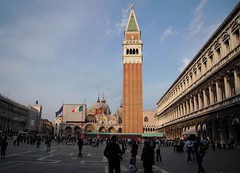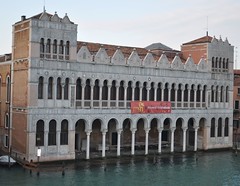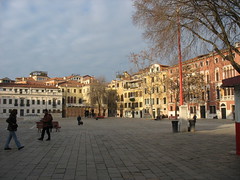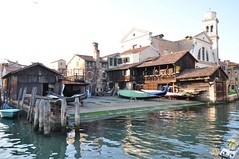Sestieri the Venice neighborhoods
Da Venicewiki, il wiki di Venezia
The Grand Canal, crossing the city, it has three on the one hand, St. Mark, Castello and Cannaregio, three of which are located in the other side of the Channel, [Santa Croce]], San Polo and Dorsoduro, calling them de Citra the first who are on this side of the channel with respect to St. Marco and de Ultra the other, which of course are on the other side of the channel. De Ultra and de Citra were also called the Prosecutors of St. Mark who dealt justice to one side or the other of the Grand Canal.
The division into districts came about in the twelfth century. At that time a war against the Byzantines put a strain on the finances of Venice and it was necessary to impose some sort of fee to the citizens, actually a kind of loan to the State, to support the expenses of war.
To make sure you collect all the money was provided to divide the city into zones sestieri to the tax collectors, also split for Sestiere, could act in a widespread manner.
The numbering of the Civic is very special. Each Sestiere part with the number 1 and continue following tortuous paths that only the postmen and employees to the delivery of goods and a few others know well.
Ends only when each door of the District has its own number, so it is not difficult to be with numbers that exceed five thousand numbers as the three Sestieri de citra.
San Marco

Of course the number 1 of the San Marco District is Door of the Charter, the main entrance of Doges' Palace near the Basilica, the other input is the Door of wheat, near the Ponte della Paglia, to finish the next Ponte dell'Olio to Fondaco dei Tedeschi
In his area there are the Teatro La Fenice, the headquarters of the Regional Consigio in Palazzo Ferro Fini, Palazzo Grassi, the Church of Santo Stefano and Town Hall Venice.
Castello
In this case the street numbers start from San Pietro di Castello to finish near the Basilica dei Santi Giovanni e Paolo.
Cannaregio
In addition to Saint Lucia Railway Station, the Jewish Ghetto (the word 'Ghetto' derives from the Venetian stream, as the area where she was imprisoned Jewish community in Venice before there was an ancient furnace for melting metal, since then all closed communities took this name precisely Ghetto), the Fondamente Nove, from where boats depart for the islands of Murano, Burano, Torcello and the Island of San Michele, the Venice cemetery, there are the Chiesa della Madonna dell'Orto, the Church of Jesuit and the small but precious Chiesa di Santa Maria dei Miracoli.
Santa Croce

It is perhaps best small in area, but richly populated, was the site of numerous activities such as wool washers.
The Rio di San Cassiano, which separates it from the San Polo, is the Ponte delle Tette, Tits Bridge.
While the No. 1 is located on the bridge near San Pantalon, at Campiello Mosca, the latest numbers are in the vicinity of Ca 'Corner of the Queen.
San Polo

In its territory we find the Chiesa di San Giacometto, a splendid example of Romanesque Church, obviously the Chiesa di San Polo ¸ great Church dedicated to St. Paul and Basilica dei Frari which exhibits on its altar, the famous Assumption of Titian.
Dorsoduro

The Campo Santa Margherita, which is located in this area, is considered the largest in the city and very much alive, both day and night, for the presence of numerous students attending the University of Ca' Foscari and that of architecture, the IUAV.
- Venice
- Doges' Palace
- St. Mark's Basilica
- Bridge of Sighs
- St. Mark's Square
- [[How to get in St. Mark's Square]
- Clock Tower




